June 1 - 30, 2025: Issue 643
Bruce Goold
August 12, 1948 – June 16, 2025
Adored son of Wilfred and Phyllis, beloved husband of Kate (Dec.), treasured father to Nancy.
Bruce says, ''The traditional colours of Avalon Beach are Red and Green. I have added a Cockatoo, wings outstretched, in Celebration. There are many of these birds in Avalon Beach.''
The concept: ‘A Jubilant Cockatoo, Wings Outstretched in Celebration of the Centenary’.
“Sulphur Crested Cockatoos are the ‘bird of the moment’ in Avalon, their raucous behaviour and happy demeanour seem ideal for a symbol to celebrate 100 years” Bruce said.
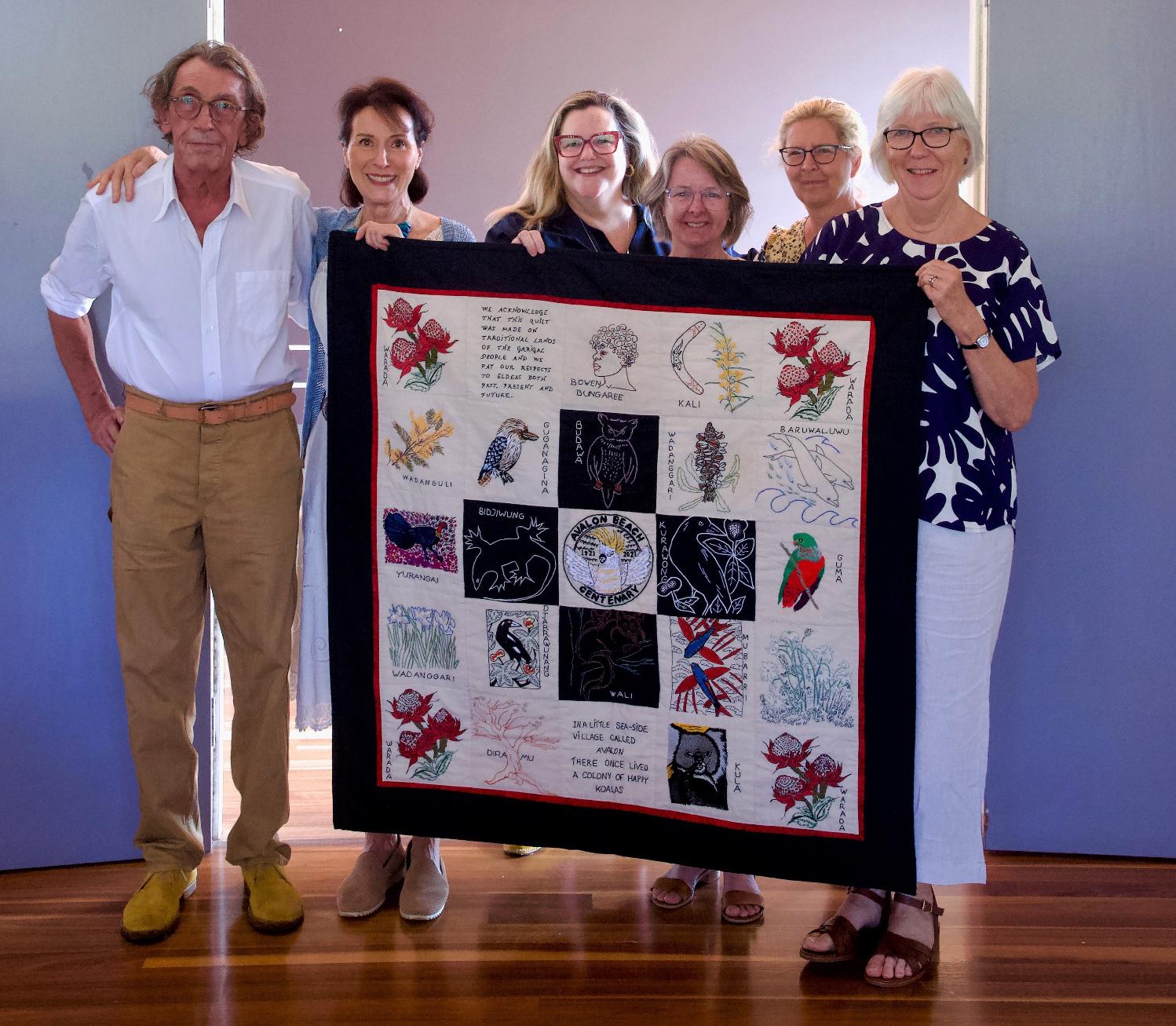
Renowned for bold graphic prints using linocuts and woodblock techniques, Bruce Goold’s instantly recognisable style established him as one of the most influential and celebrated artists in Australia. Goold was famous for his use of woodcut and lino techniques, which drew on the skill of hand cutting designs, using the positive and negative spaces to create beds for ink application. Once printed the designs come to life, with depth and texture.
For Bruce, Art is not just for the walls, it can be worn, and then it is not just about the style and cut of the cloth, it is about what the printed threads bring together; the colours, the subject, and with so many Australian birds, wildflowers, his designs were unapologetic celebrations of here and a call to immerse yourself in living Art.
There are not many locals who do not have a t-shirt, a cushion, a curtain, a Mambo shirt in his favoured themes of marine, flora and fauna, the tropical and those he called 'curiosities' - a kind of Edward Lear nonsense poem, only Bruce's acutely epitomised version.
Bruce was a joy-maker, who called all to allow themselves to be immersed. His smile, his dancing, were about sharing we are all living in a vision, knit currents of air, earth and water, and in these threads and their verses we too are all connected too to the Creative in all of us.
But even his prints for walls were careful whole pieces. After the design was finished and ready for the paper, the next p[art of the process began. I recall him quietly explaining the quality of the paper chosen - and the inks.
"They are printed on Velin Arches, 275-300 gsm, warm white paper, using a flat bed press with Charbonnel black etching ink. The print is allowed to become touch dry before it is hand coloured using the finest French Linel gouache."
And all were limited editions, usually made in runs of 25, each one a special other baby, laid over very special skin before the cloak atop that adds its distinct layers, that went into the world to share its essence for as long as it exists, even in memory, even in those forms that were commercial art.
The depiction of Australian flora and fauna in Bruce Goold’s eclectic style is what makes his designs so iconic.
He explained he first discovered woodblock prints while visiting his father’s store:
“A successful block print can hang in the street and not look amiss. Since the inception of the alphabet for block-printed publications and the subsequent hand-engraved illustrations that accompanied them, text and image have a matching strength. As a visual vocabulary the block-printed illustration can be understood in the same way as the written word: proclamations, posters of all sorts – ‘Wanted’, circus, travel. Hand-printed images designed to strike attention appeal to me. Dating from early Chinese block prints and Coptic textiles to graphic French posters, the block print has a timeless authenticity.
My father had a furniture and decorating store with many swatches of fabrics and wallpaper books which I pored over when visiting and occasionally working there, so I like fabrics. When I first saw the woodblock prints Raoul Dufy did for Bianchini-Ferrier in the 1930’s I was very excited and keen to work in this way.”
“I have always loved the look of relief prints. A woman who lived in our street when I was a schoolboy was an artist and her son was good friend. At age 12 she gave us both some lino squares and tools and I did my first linocut. At art school I went on to do more, inspired by the German Expressionist woodcuts of Kirchner and Nolde."
That's where it all began of course, the Goold Interiors store in Newcastle, which made everything; bedspreads, curtains, would cover lampshades in what people chose.
His grandfather W.J. Goold founded Goold's Pty Ltd in 1929. He was a well-known authority on the area, (he founded the Newcastle Historical Society), and kept a private museum in the large billiard room in the fernery at the back of the house. This contained scale-model ships, maritime embroideries, convict leg-irons, aboriginal boomerangs and documents of research for his journals.
His father Wilfred trained with Archibald prize winner Henry Hanke before enlisting in the Royal Australian Air Force and serving as a Spitfire pilot during WWII, for which he was awarded the Distinguished Flying Cross. Wilfred kept some excellent sketchbooks during his service in Burma, assured pencil drawings of the tropical landscape, the Burmese locals and fellow airmen.
On his return to Newcastle Wilfred took over the furniture business, married Phyllis, his pre-war sweetheart, moved to the family holiday house on the shores of Lake Macquarie and started a family.
Notices from the newspapers of then record:
BIRTH. GOOLD.--To Phyllis and Wilfred- a son--born Centaur Hospital, August 12, 1948. Family Notices (1948, August 16). Newcastle Morning Herald and Miners' Advocate (NSW : 1876 - 1954), p. 2. Retrieved from http://nla.gov.au/nla.news-article140346960
Prior to that day it is apparent creativity was in his father's nature too:
COMING OF AGE PARTY Mr. and Mrs. W. J. Goold entertained at their home, "Edgbaston," Hamilton, on Saturday night in honour of the coming of age of their elder son, Mr. Wilfred Goold. The supper room was attractively decorated in tones of lemon and green, and tables and chairs were set on the lawn. Mr. Goold was presented with a watch on behalf of his family. Mr. Gordon Gray proposed the toast of the guest of honour. Mr. Russell Moore also spoke. Mr. Colin Maples proposed the toast of Mr. and Mrs. Goold, which was supported by Mr. A. Booth. Miss Beryl Sneesby conveyed her congratulations to the guest of honour in a witty poem. COMING OF AGE PARTY (1940, February 6). Newcastle Morning Herald and Miners' Advocate (NSW : 1876 - 1954), p. 2. Retrieved from http://nla.gov.au/nla.news-article140521911
AIR FORCE TRAINEE ENTERTAINED Mr. Wilfred Goold, who left Newcastle yesterday to enter an Air Force training base, was the guest of honour at a party at the home of his parents, Mr. and Mrs W. W J. Goold, of Hamilton, on Saturday evening. About 35 guests were entertained with games, competitions, and a movie camera record of holidays spent recently by Mr. Wilfred Goold and friends. Hydrangeas decorated the reception rooms, the supper tables being decorated in red, white and blue. A presentation was made to Mr. Goold on behalf of his friends. AIR FORCE TRAINEE ENTERTAINED (1940, December 9). Newcastle Morning Herald and Miners' Advocate (NSW : 1876 - 1954), p. 6. Retrieved from http://nla.gov.au/nla.news-article132800509
Engagement Announced at C.W.A. Dance
'The officers' mess at Fort Scratchley and the Country Women's Association Younger Set held a dance at the Drill Hall, Newcastle West, on Saturday night. Proceeds will help the Country Women's Association buy war comforts.
At the dance Miss Phyllis Silkman announced her engagement to Leading-Aircraftsman Wilfred Goold. Miss Silkman, who is the eldest daughter of Mr. N. Silkman, of Sydney, wore a spray of frangipanni at the waistline of her ivory lace gown. Leading-Aircraftsman Goold is the eldest son of Mr. and Mrs. W. J. Goold. of Hamilton. The official party included Commander and Mrs. Hopkins. Squadron-Leader and Mrs. Paget, the President of the officers' mess at Fort Scratchley (Major F. Harden) and Mrs: Harden, Captain and Mrs. Bernard, Lieutenant and Mrs. Ford, the President of the Country Women's Association (Mrs. W. E. Hutton). the Secretary (Mrs. A. Frew), the President of the C.W.A. Younger Set (Miss D. Fisher). the -Secretary (Miss J. Mullens) and the Treasurer (Miss P. Preshaw). Mrs. Paget wore a gown of honey brown moire taffeta: Mrs. Harden was in magnolia coloured satin; Mrs. Hopkins chose a smartly cut gown of black taffeta: Mrs. Bernard was in a forest green coloured gown; Mrs. Hutton wore a metal-run black coat over her matching sheer gown; Mrs. Frew favoured a gaily patterned gown in red and white; Mrs. Ford was in a white crepe gown, worn with a lilac coloured coat; Miss Fisher chose a gown of heather coloured 'lame, with a matching velvet coat; Miss Preshaw had white trimming on her floral linen gown; Miss Mullens allied a black skirt with a lace blouse; Miss Helen O'Dwyer (Sydney) was in black chiffon. Engagement Announced at C.W.A. Dance (1941, March 31). Newcastle Morning Herald and Miners' Advocate (NSW : 1876 - 1954), p. 2. Retrieved from http://nla.gov.au/nla.news-article140429501
Phyllis served in Women’s Auxiliary Air Force during World War Two.
Newcastle Man in R.A.F. Unit
Sergeant - Pilot Wilfred Goold. son of Mr. and Mrs. W. G. Goold. of Newcastle. is a member of a R.A. F. hurri-bomber, (Hurricane) squadron which sweeps in from extremely low altitudes. Sergeant - Pilot Goold received his elementary training at Tamworth. and secured his wings at Wagga. He left Australia for England in August last year. He is attached to an operational station the North of England. Well known in Newcastle. he was educated at Hamilton Public School and Newcastle Boys' High School. He played with the Central Rugby League under 18 team. He is well known in swimming and life-saving circles. He was in business with his father when he enlisted. He is aged 23. Newcastle Man in R.A.F. Unit (1942, February 20). Newcastle Morning Herald and Miners' Advocate (NSW : 1876 - 1954), p. 3. Retrieved from http://nla.gov.au/nla.news-article140407810
D.F.C. FOR NEWCASTLE AIRMAN Advice has been received by Mr. and Mrs. W. J. Goold, of Hamilton, that their son, Flying Officer Wilfred Arthur Goold, has been awarded the D.F.C. Flying Officer Goold, who is 25, flew fighter planes for three years with an R.A.F. squadron in India, mostly on the Burma frontier. He returned to Australia in June. He married shortly after his return. D.F.C. FOR NEWCASTLE AIRMAN (1944, September 18). Newcastle Morning Herald and Miners' Advocate (NSW : 1876 - 1954), p. 2. Retrieved from http://nla.gov.au/nla.news-article134260514
DUKE DECORATES AIRMAN At an investiture at Government House last Friday, Flight-Lieut. Wilfred Goold, of Hamilton, was decorated by the Duke of Gloucester with the D.F.C. The citation showed that he had three years' service with an R.A.F. fighter squadron in England and Burma, his record including the shooting down of four enemy fighters, the probable destroying of one fighter; and the damaging of five others. He is a son of the President of the Newcastle Historical Society (Mr. W. J. Goold) and Mrs. Goold. He had now resumed an active part in his father's business. DUKE DECORATES AIRMAN (1946, August 12). Newcastle Morning Herald and Miners' Advocate (NSW : 1876 - 1954), p. 2. Retrieved from http://nla.gov.au/nla.news-article133180182
Mr. Wilfred Goold has designed a sign inscribed with the name of an early pioneer, to be attached to each loge. On each he has painted an appropriate scene to denote the particular enterprise in which the pioneer made his name. Under the scene will be indicated in which sphere the pioneer became famous-settlement, civic, coal, industry, commerce, manufacture, shipping or steel. Pioneers' Descendants To Attend Historical Ball (1947, September 5). Newcastle Morning Herald and Miners' Advocate (NSW : 1876 - 1954), p. 8. Retrieved from http://nla.gov.au/nla.news-article134235697
Bruce's older brother:
GOOLD.-To Mr. and Mrs. W. A. Goold (nee Phyllis Silkman), at Centaur Hospital, January 2, 1946-a son (Douglas Wilfred). Family Notices (1946, January 5). Newcastle Morning Herald and Miners' Advocate (NSW : 1876 - 1954), p. 2. Retrieved from http://nla.gov.au/nla.news-article140617490
In a 2008 interview with curator Rosie Nice, reproduced in the catalogue 'Bruce Goold - Artist • Designer • Printmaker, Manly Art Gallery & Museum, 2008', Bruce explained they first lived on the shores of Lake Macquarie:
"I still remember the lake, the octopus nest at the end of the jetty, swimming with my brother and sister and the Catalina flying-boats landing at Rathmines on the other side of the bay. I think that’s why I am attracted to Pittwater. We moved closer to town in the 50s, the leafy bushland suburb of New Lambton.
My father's stylish and artistic bent turned the conservative furniture store into a cutting-edge design showcase, selling the popular Danish and Swedish styles of the 1960s: Grant Featherston chairs, Thonet bentwood, hand-printed fabrics and wallpaper, many of which have since becomes classics of 20th century Australian design."
This early connection to the sea and its vistas would continue to inspire future Marine themed works. Bruce related his "Pasha Bulker'' was inspired by seeing the Pasha Bulker run aground during a major storm on June 8 2007 on Nobbys Beach.
Early on the morning of 8 June 2007, Newcastle Port Corporation radioed the 56 moored ships waiting off the coast to load coal to warn them to move out to sea to escape an approaching storm. Pasha Bulker, along with 10 other ships, did not heed the warning. As the storm hit, Pasha Bulker could not clear the coast and beached at 9:51 a.m. The ship never called for tug assistance, ran aground with a fully operational engine room and still had both anchors stored in the hawsepipes leading some maritime experts to believe that proper precautions were not taken by the ship's captain.
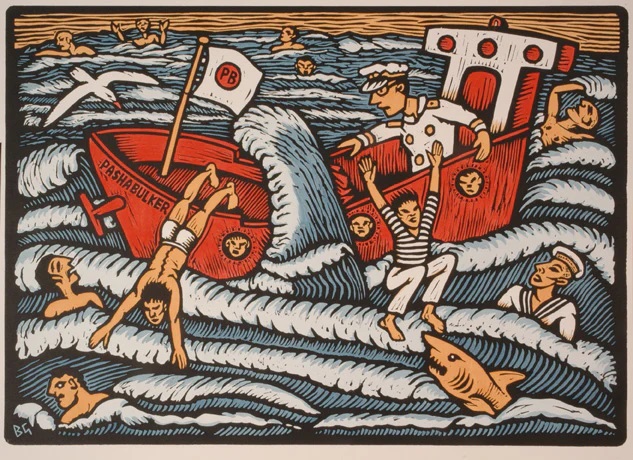
Pasha Bulker by Bruce Goold (2008)
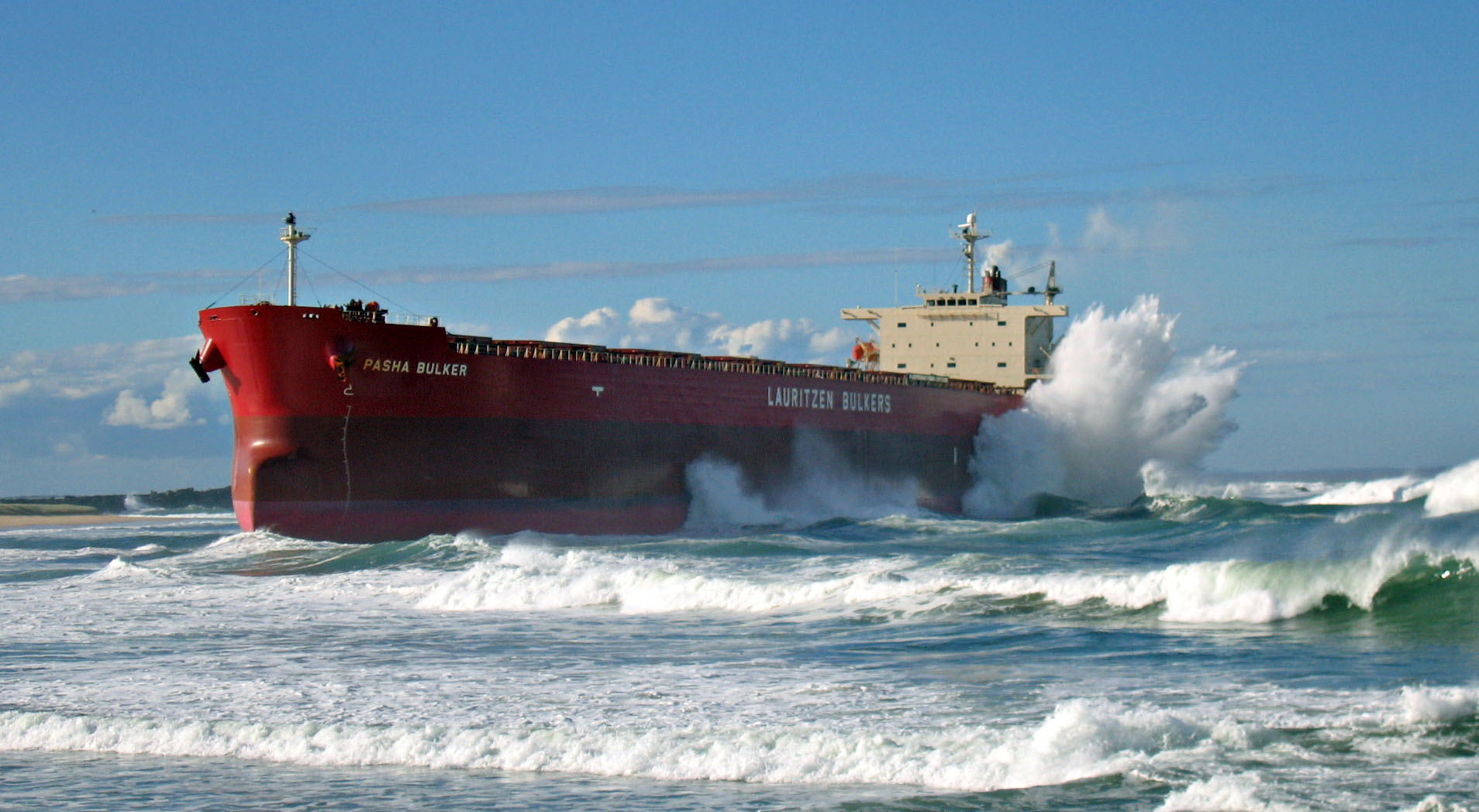
Pasha Bulker, June 2007. Photo: Tim J Keegan, Lake Macquarie
Wilfred Goold taught Bruce rudimentary drawing skills, and he would pore over art books and Classic Comics bought by his father at Central Station on his trips to Sydney, and these inspired his own similar illustrations of then.
From 1961-65 Bruce attended Sydney Grammar School, where he studied art for the Intermediate Certificate. His art teacher, ceramicist and potter Gordon McCausland, would take him on regular trips to the Art Gallery of New South Wales, and taught him cold casting using fiberglass resin, and other experimental techniques. This was followed by a year at the National Art School, Newcastle, where art books inspired his trying out others styles before making his first linocut - a nude of a still life. He then went to the National Art School, Sydney (1968).

Bruce in 1967, during his Art School years
After a further year, this time at the East Sydney Technical College, Bruce left and moved to rustic Balmain in Sydney’s inner west.
Bruce said: "Living in the boatshed of a New Orleans style house on the shores of Mort Bay, I worked for Elaine Townshend, of Cash Palace fame, who sold vintage clothes at Paddy's Market. She gave me a silk top hat and tails, and I spruiked for her. ‘Sergeant Pepper’s Lonely Hearts Club Band’ was in the air, and the English pop artist Peter Blake's collaged Beatles album cover informed a new way of dressing."
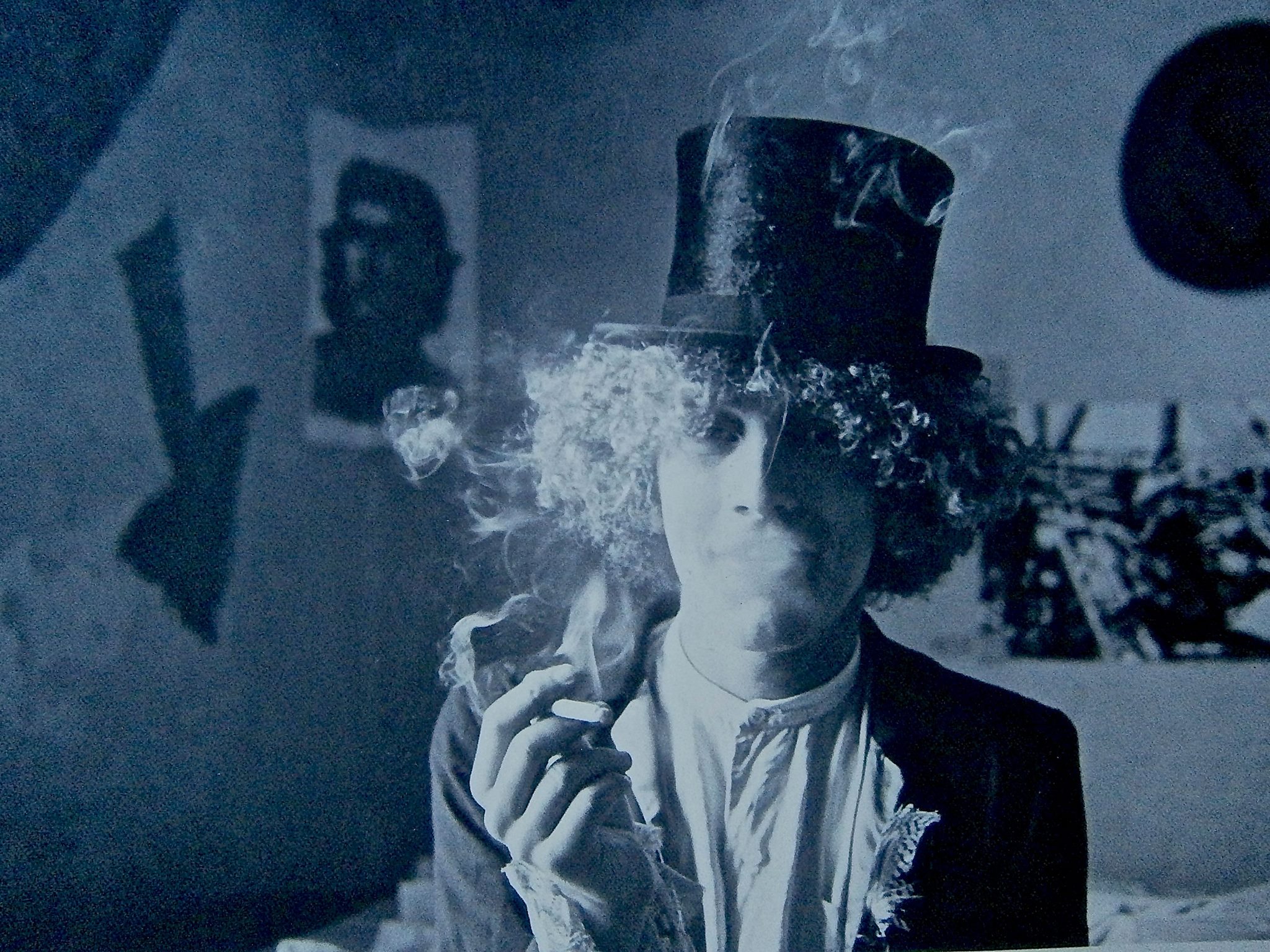
Bruce in 1969
Bruce was a member of the artist collective Yellow House between 1970-72. The Clune Gallery was transformed into an artists' collective reminiscent of the 1920s scene, when Martin Sharp opened the Yellow House in 1970. Based on Vincent Van Gogh's ideal collective, Sharp and his artistic band painted the exterior bright yellow and covered its internal walls with murals, portraits and decoration. Artists such as Brett Whiteley, Bruce Goold and Peter Kingston turned the building into an art work, while visiting bands and celebrities made it a regular fixture of the Sydney scene.
Fellow Yellow House Artist of then George Gittoes posted on social media on Friday:
"I first met Bruce at 49 Macleay St Potts Point in early 1970, before it became the Yellow House. We walked across the street together and brought a loaf of bread from a Bakers Van, breaking it in half and that was our first meal together. Bruce was strikingly handsome with his blond Afro head of curly hair, Carnaby Road bell bottoms and what looked like a girl's floral blouse. He quickly took over my styling and handed me a satin coat with beautifully embroidered dragons “saying if you are an artist you have to also be a showman and need to dress like one."
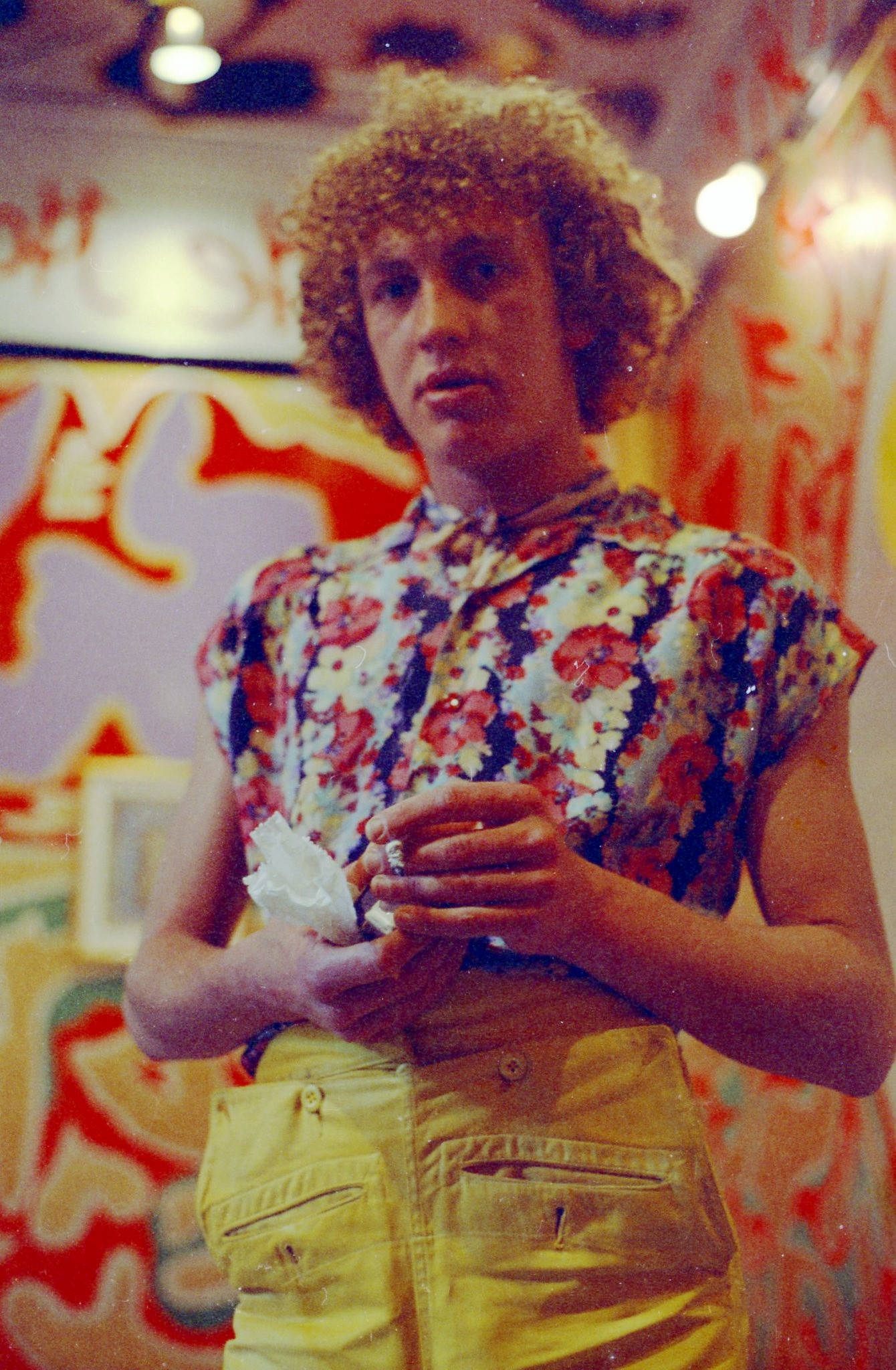
His fine and exotic clothes, however, did not stop Bruce from engaging in hard physical work. We went and hired a large and very heavy rotary sanding machine and carried it up William Street from the hardware. Bruce then set about sanding the wooden floors.
As I painted the Puppet Room Bruce created a decorated corner, among the Magritte installations, placing a chaise lounge and throwing a white polar bear skin over it.
I was born in December 1949 and Bruce in 1948 and our close mate, photographer and video artist Jon Lewis in 1950. Then there was Bliss, Moth and Jewelia, the mime in our team of friends. That corner of Potts Point, Kings Cross became like a scene from the Montparnasse of Modigliani, Soutine and Picasso, a bohemian art quarter. The gangs of bikers, American GI's on drunken R&R leave, strippers, prostitutes and their pimps were no longer in control, we were! We feared nothing and no one messed with Bruce.
When I mention Bruce Goold to people they say "you mean the printmaker", but Bruce was a polymath and a true Renaissance artist, brilliant in many mediums from performance art to fashion and dance. He was living in Victoria Street in a 3-story terrace near the top of the steps that lead to Woolloomooloo. He took me to see his drawings of seagulls and other birds. They were at a Brett Whitely level of brilliance. Exquisite works on paper using pen and blue ink. I was astonished by his graphic talent.
Bruces' favourite scavenging place was the Salvation Army Tempe Tip. I would drive him there, in a St George Cab which was my source of night shift capital. On the way down Princes Highway, Bruce recounted every detail of Huysman's book ‘Against Nature’. It was Bruce's bible, and he told the story as if he had lived it in another life. An aesthetic creates a world within his residence which reflects his taste and imagination and is a substitute for the outer realities of normal life which he despises. Bruce told me the Yellow House would have to be like this space, but our creation would be open to the public. When they walked through the doors, they would leave Australia behind and enter an artist vision of reality. Off the street and into what Martin Sharp described as 'the Street of Dreams'.
My most indelible image of Bruce performing was one night he had hung a thick strip of some kind of plastic substance on a hook from a wire and lit it. He danced under and around it shirtless with molten chunks of the material falling from it, with him managing to dodge them as he swayed and moved like Nijinsky."
"I had two puppet theatres, one in the room up the stairway to the second floor and a canvas booth set in our garden, café-courtyard.
In both places Bruce would be the link between the audience and the puppets. The most memorable night was in the garden. We were wired with adrenaline because we saw, in the front row of a packed audience, sat Barry Humphries, at the height of his satirical career and the famous witch of Kings Cross, Rosalyn Norton. Plus, the theatre reviewer for the Sydney Morning Herald, Michael Symons."
"Bruce and I were so over excited at the success of our show we sneaked out through the back fence to the adjoining lane and literally did ecstatic cartwheels.
The next day Michael Symon wrote a rave review for the SMH with the headline PUPPETS UNDER THE STARS.
I have too many wonderful memories of Bruce to fit them into this tribute. For weeks before his death I felt him reaching out to me and he was constantly on my mind. This morning, I saw him sitting in an antique cane chair, leaning on two of his sunflower printed pillows, in my studio, watching me paint and giving great advice, like he always has.
Bruce was the truest of true artist, pure in spirit and I know he has been with me as I have written this as tears have been welling in my eyes and running down my cheeks."
The Bulletin ran:

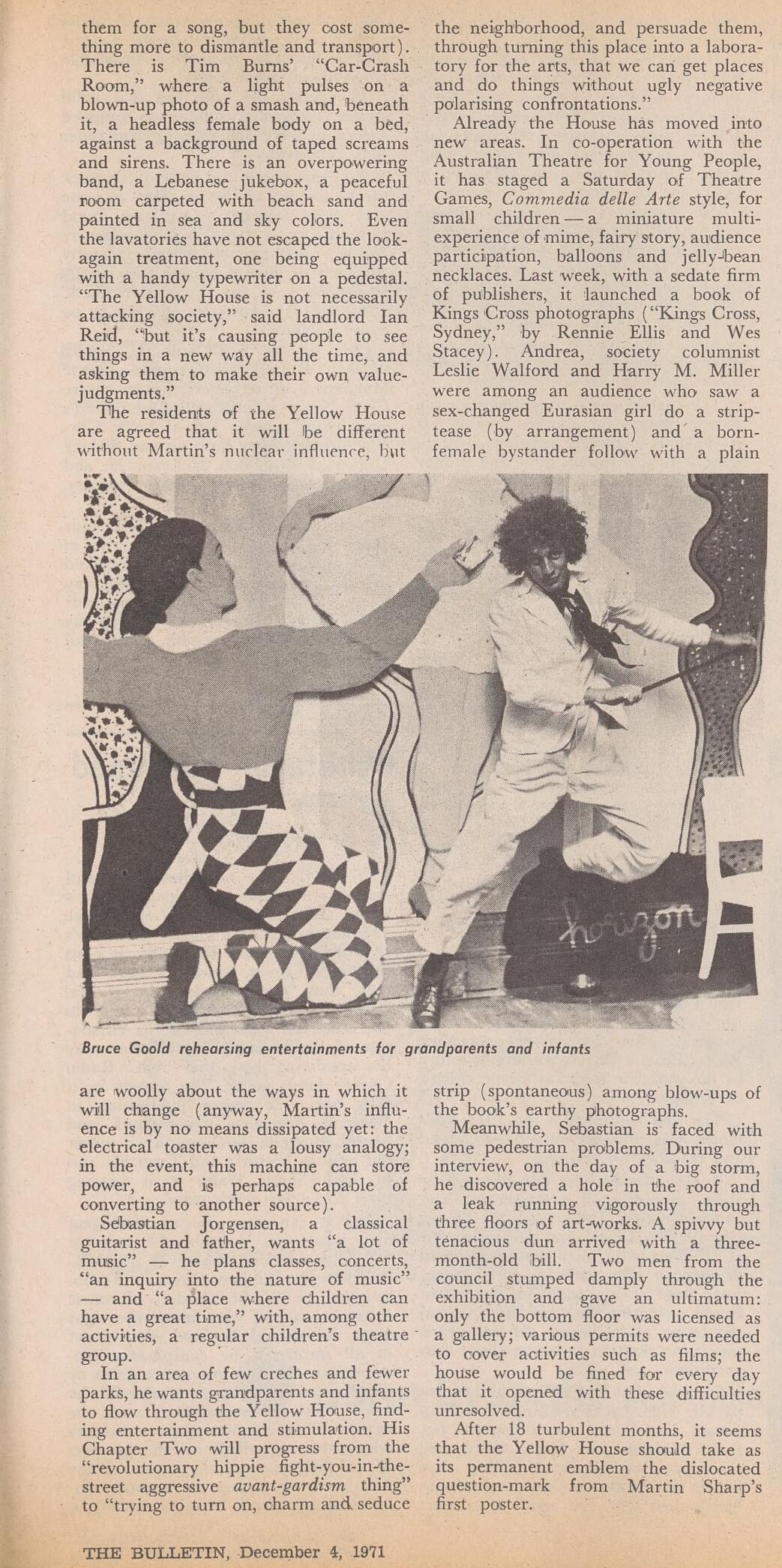
Others joining Sharp at the Yellow House were Mick Glasheen, Peter Kingston, Jon Lewis, Tim Lewis, Albie Thoms, Greg Weight, Dick Weight, Brett Whitely and Peter Wright, along with a who's who of emerging Australian creatives.
Bruce recalled: "When it opened to the public, many were confused as to whether it was a gallery, a King’s Cross offshoot of Luna Park, or a surreal set from Dali’s dream sequence in Alfred Hitchcock's movie Spellbound. After creating their environments, some of the contributing artists became exhibits themselves: private bedroom doors were opened by the inquisitive only to reveal a preTracy Emin mattress installation of domestic neglect. Sometimes I was the vendeuse, hoping to sell the framed art, sometimes Virgil, guiding the uninitiated through the labyrinth of rooms. Much of the art they made, and the performances they staged were transitory, but the influence of those days lived on, affecting the future lives of the young artists and those who came to see them."
When they were all evicted from the Yellow House Bruce stayed with the Whiteleys at Lavender Bay and helped Brett prepare for his exhibition, ‘Portraits and other Emergencies’ at the Bonython Gallery (February 1972). Friends of the Whiteleys' from Ireland, Noel and Liz Sheridan and family, came to Sydney to stay with them at Lavender Bay and Bruce moved with the Sheridan’s to rent three shops with upstairs rooms in Elizabeth Street, Surry Hills where they sold the unusual and 'fabulous stuff' found at auctions. It was around this time he met and married his wife, Kate.
At this time Noel Sheridan shifted away from being a Painter into another form of art. Bruce recalled:
"Unbeknown to the outside world, a strangely ancient, newly interpreted world of shadows was forming on Noel Sheridan's dream screen. Noel had written the shadow play Penumbra to be enacted behind vast white Holland blind screens with: objects, skilled lighting and a couple of shadow actors, in the style of the pre-cinema French phantasmagoria and tableaux vivants. Set in some indeterminate film noir period, I played The Guy, dancing with a bentwood chair to the Inkspots, strangling my unfaithful lover with her scarf as we tangoed to the strains of ‘Jalousie’. Fantastic shadow images were painted with light across the screen, velvet-textured greys, eerie green and red spots illuminated a birdcage, a hanging lamp, and the wicker mesh on the chair."
Rosie Nice states in her essay this had a strong influence on Bruce’s later linocuts, which he has described as 'silhouettes or shadows highlighted with engraving'.
Through 1973-74 he and Kate, travelled immersing themselves in greens and big blue skies of Bali, Singapore, Bangkok, Laos, Nepal, India and Pakistan. They returned to live here, in Pittwater, in 1975.

Nepal 1974.
Bruce: ''Surprised to get this email photo today from Judah Ruben, an American Kate and I met while travelling in Nepal for 3 months. Equally surprised at my outfit, which seemed quite normal for an adventurer in the Himalayas at the time, Texan boots for trekking which I didn’t attempt, Bhutanese silk scarf, meant as a gift to a holy lama, look happy on the top of the world!"
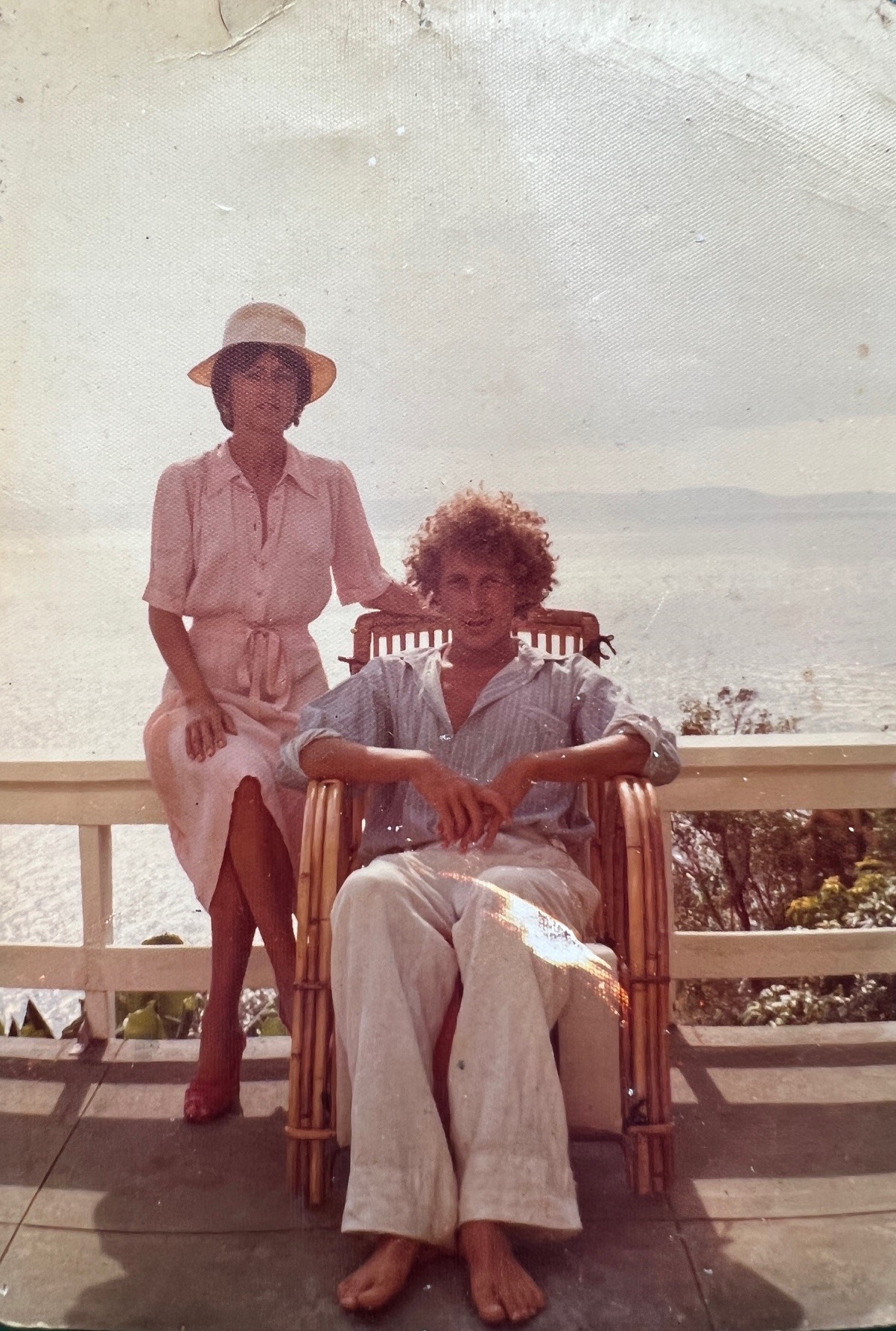
Katie and Bruce at Rayner Road Whale Beach, 1977
As a young artist developing his style and aesthetics, Bruce was impressed by the exhibition A Survey of Australian Printmakers at the Ward Gallery in Glebe, Sydney, which showed the work of Australian artists from 1900 to the 1950s.
In 1976 Nicholas Draffin, then curator of prints and drawings at the Art Gallery of New South Wales, published his book Australian Woodcuts and Linocuts of the 20s and 30s, (ISBN 0 7251 0224 1) which reinforced his interest. An antipodean form of American and English Abstract Expressionism dominated the post-war period; ‘floral still life' was badged unfashionable and decorative. Now this aesthetic was re-emerging in the 1970s through the rediscovery of these skilfully executed and powerful images. Bruce had found a medium that suited his artistic and still itinerant lifestyle. He bought squares of linoleum, cutting tools, ink, Japanese paper and a bamboo printer’s barren.
Bruce said: "I was smitten by the images of Australian flora and fauna and the quality and power of the works by the best practitioners of the period: A standout was the bold woodcut of banksias by Margaret Preston, black ink on cream paper, toughly incised, redolent of the savage cones and serrated leaves after a bushfire. I did of a couple of linocuts of Banksias cut from the garden at Whale Beach that looked quite Prestonish, hard to avoid when you have the same subject and are working in a similar medium, but I was thrilled with the result. Currawongs, magpies, kangaroo, strelitzias, iris, anthropomorphic birds and neo-expressionist figurative works followed, punctuated by spiky banksias and waratahs.
The prints mounted up as Goold developed his style and proficiency. In 1979, Leo and Anne Schofield offered Bruce his first exhibition of linocuts at the Queen Street Galleries in Woollahra. The show resembled a 1930s salon; an antique glass showcase displayed the lino tools and printing paraphernalia, a large vase of wildflowers resplendent on the desk.
At the Rex Irwin Art Gallery, 1st floor, 38 Queen St., Woollahara, Sydney, in November 1979:
Sculpture speaks louder than words
BY ROTH FAERBER
Like much contemporary sculpture which does not propose a literary concept, nor even follow an arrangement of formal design, the work of John Davis at Watters Gallery, creates impact by its presence; and for which words only provide a poor substitute.
A Melbourne sculptor who represented Australia at the last Venice Biennale, he neither carves nor models (within traditional understanding of the term) but he assembles, ties, binds and hand-sews.
Obviously to do so he is using likewise untraditional materials: mainly unbleached calico, twigs, string, papier mache forms, stones, branches.
Degas’s “Little Dancer” created the precedence in the early 19th century for the use of “real” materials, but for a purpose of describing a specific idea.
Davis’ concept is intimately bound up with the character of his materials, which interract with and are juxtaposed upon each other. The natural identity of each, combined in extended floor assemblages or loosely structured object, infers rather than describes the quality of natural growth.
The pale whiteness and earthy browns make a gentle visual poem which defies transcription into another medium.
Upstairs Imants Tillers in “52 Displacements” makes witty work out of a serious title. His52 small scale “paintings of paintings” (including detailed rendering of frames) represent the subject of seascapes.
In varying moods under varying conditions, and in styles that point to art history’s various interpretation, image, time, water and feeling become the unifying theme.
At the Art of Man Gallery, the paintings of Karin Oom treats landscape abstractly with fluid washes and high keyed color approaching a lyrical interpretation of rarified air and evanescent mood.
ACCENTS
Calligraphic accents which become more dominant in her accompanying crayon lithographs, lithographs, provide an undercurrent of energy and vitality to an otherwise tentative approach.
At the same gallery the first one woman show of the sculpture of Jan King impresses by its resolvement of concept and clarity of means. Wrought and cast iron, in a rusted or painted state, is forthrightly employed to describe movement in space.
The fan-like roll of “Unfold,” the juxtaposed levels of “Ripple,” or the forward thrust of “Arise,” use mass and linear forms without any self-conscious assumption.
Nicholas Pope is an American sculptor whose limited show at Gallery A uses timber with self-conscious bravura.
Aggressively cohering wood piles of silver birch, pine and cherry wood, his clear cut statements are a forceful implication of mechanical power over nature, put to decorative use.
A sense of enforcement in contrast to Davis.
ETCHINGS
Rex Irwin exhibits a collection of etchings and lithographs by David Hockney, dating from the ‘60’s, which underlies the masterly technique and free wheeling imagination on which his reputation is based. Without exception each piece is superb, whether as illustration (to the Grimm Fairy Tale series), a penetrating portrait or delicate flower study. Recent essays into color, however, add nothing to the quality.
On the upper level the lino cuts of Bruce Goold depend very much on color for their effect. Looking back to the Margaret Preston prints of the ‘30’s they are nevertheless a welcome addition to the field of decorative printmaking. Sculpture speaks louder than words (1979, November 8). The Australian Jewish Times (Sydney, NSW : 1953 - 1990), p. 14. Retrieved from http://nla.gov.au/nla.news-article263248068
This had been preceded by, in the Spring of 1978, the arrival of his other adored girl:

Bruce and his daughter Nancy at Palm Beach, 1981
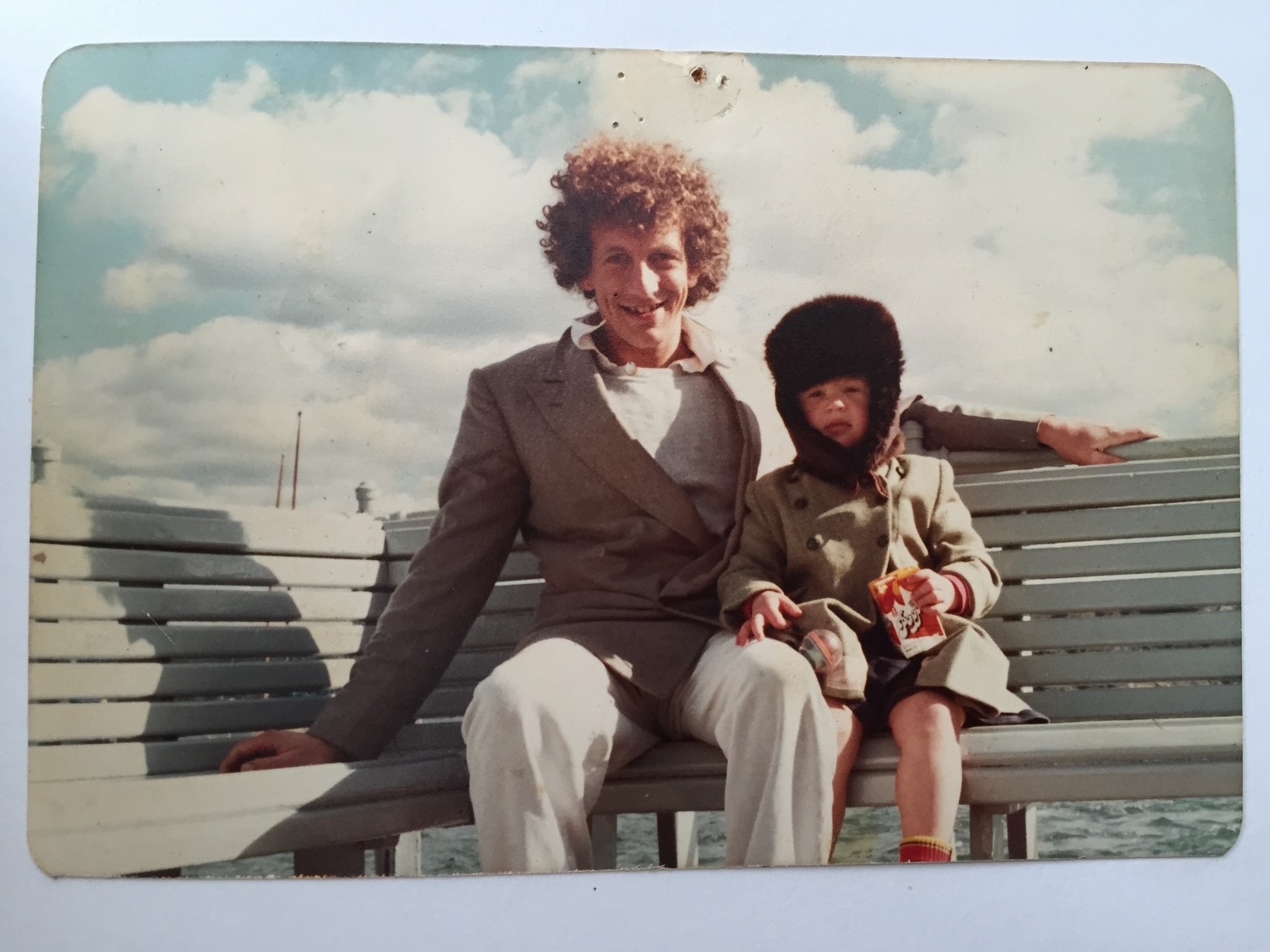
Bruce and his daughter Nancy on Palm Beach Ferry
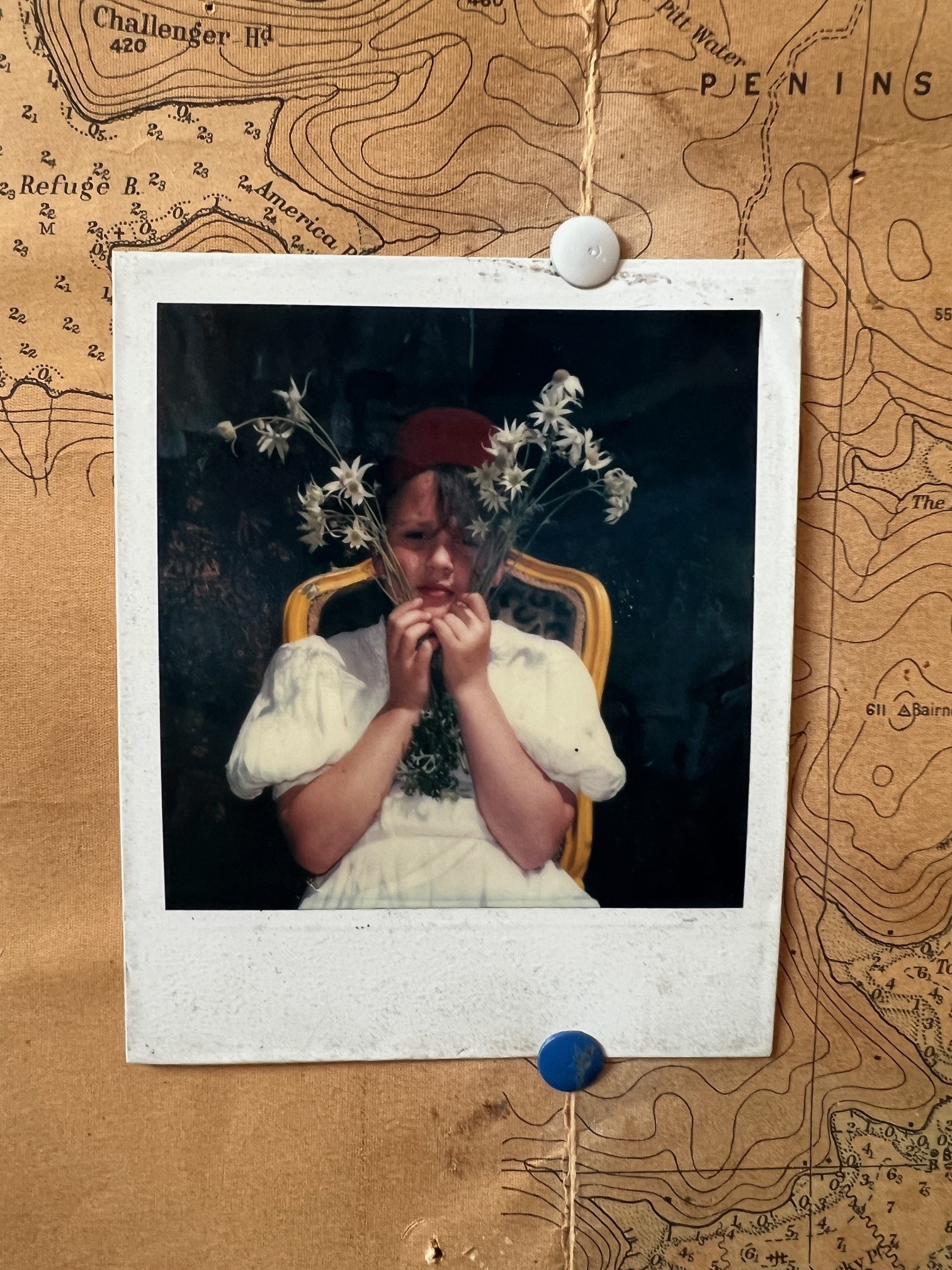
Nancy with Fez and Flannel Flowers sitting on a chair that was hand painted by Bruce. ''Dress ups with me was an extension of his creativity. I’m approx 10 years old.'' Nancy shared this week.
The early 1980's; Bruce's range of fabrics are 'expanded' and available at and through the best of the best:
THE ENGLISH AUSTRALIAN FASHION DISCOVER - AT LAST!
"We're pioneering Australiana into fashion" say Jenny Kee and Linda Jackson, designers behind the flamboyant Flamingo Park label. And England, though startled at first, loves their originality, reports Julie Clarke
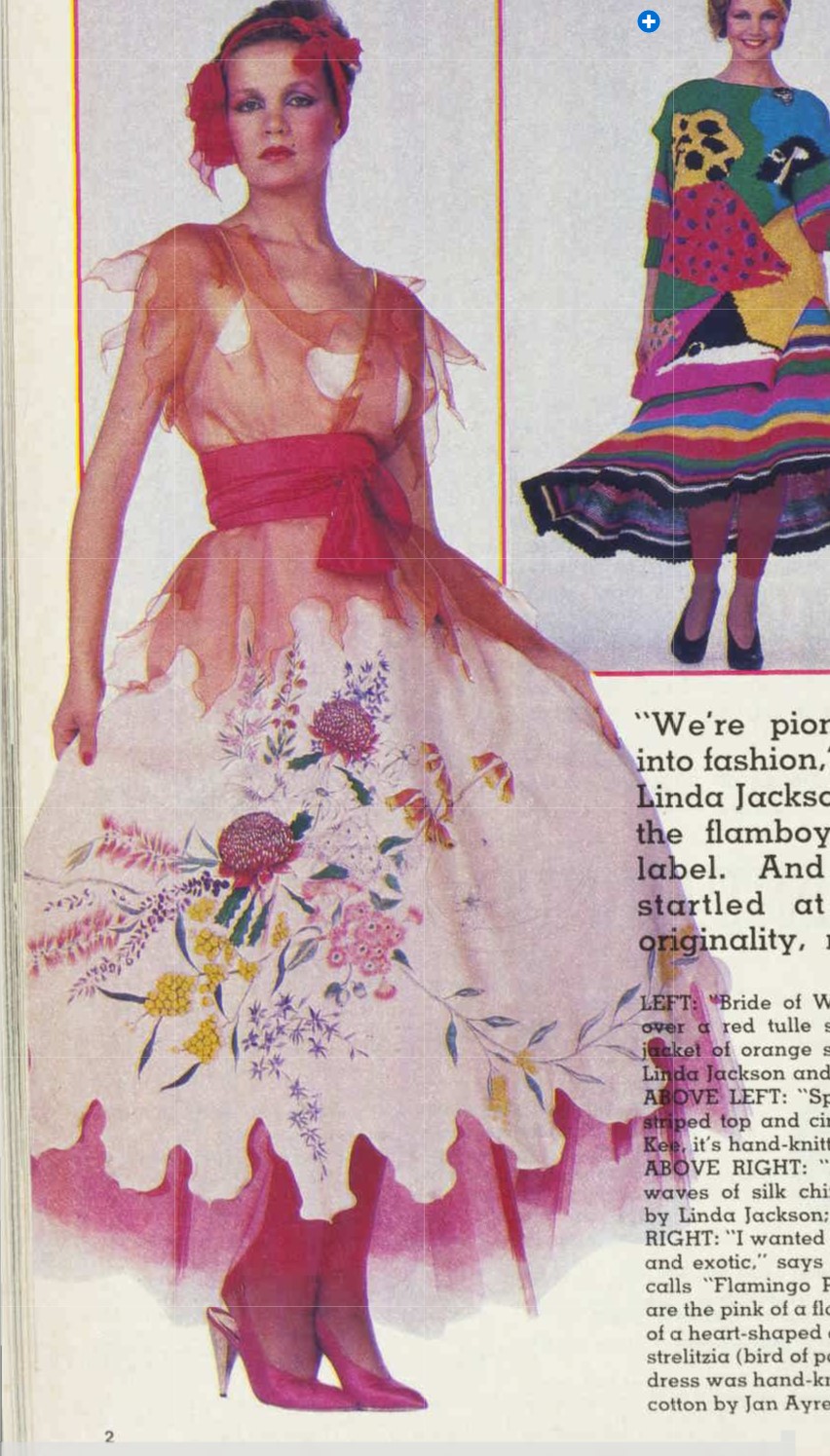
LEFT: "Bride of Wildflowers," a petal silk dress over a red tulle skirt with tightly sashed petal jacket of orange silk organza, was designed by Linda Jackson and hand-painted by Bruce Goold.
ABOVE LEFT: "Spotty Fishes" tabard goes over striped top and circular skirt. Designed by Jenny Kee, it's hand-knitted in pure cotton by Jan Ayres.

ABOVE RIGHT: "Blue Ringed Fish" chemise in waves of silk chiffon with coral skirt, designed by Linda Jackson; hand-painted by Bruce Goold.
RIGHT: "I wanted to design something passionate and exotic." says Jenny Kee about the dress she calls "Flamingo Passion." In its vibrant colours are the pink of a flamingo, the red of hearts and of a heart-shaped anthurium, and the brilliant strelitzia (bird of paradise flower). The dress was hand-knitted in pure cotton by Jan Ayres.
Mick Jagger was photographed in one of Jenny's kangaroo cardigans. Nureyev bought bagfuls of the distinctive Aussie woollies when he was here, as did "Monty Python" wit and writer Eric Idle who couldn't resist fashion with a sense of humour.
In New York, Gerry Stutz of Bendel's department store adored their designs, describing them as "at least three years ahead of the times."
In Rome, Italian "Vogue" announced with a colourful double page splash, "Fashion arrives from another hemisphere," and when Linda and Jenny walked into a party of fashion luminaries in Milan, they received a standing ovation.
In Paris, at an exhibition of paintings by Sonia Delaunay, to which Linda and Jenny wore their own Delaunay-inspired patchwork dresses, gallery goers forgot the paintings and stared open-mouthed at the daring fashion duo from Down Under.
And now, the London "Times," after a double-take when the latest Flamingo Park designs hit the fashion editor's desk, have devoted four colour pages of the "Sunday Times Magazine" to Flamingo Park wattle and gum-nut frocks, and a story explaining the quaint new upsurge of Australiana, which may well, as a result, become the next hot seller at Sotheby's, the famous auctioneers. So hang on to your plaster kookaburras.
"We're pioneering Australiana into fashion," says Jenny Kee. "That's never been done before. My customers from London and Paris and New York find the images very exotic. I mean, they've never even heard of a banksia before, let alone seen one abstracted and knitted into a dress using 18 different colours."
The unique magic of Flamingo Park
("Step into Paradise" says a sign on the door), grew from the complementary creative relationship of Linda Jackson and Jenny Kee. Both returned to Australia in 1972 after studying and working with fashion in Europe.
Jenny presided over a famous retro clothing stall in London's Chelsea Antique Market, while Linda had haunted the workrooms of what remained of the famous French couturiers while she worked as a dressmaker, and travelled the East studying fabric and design.
Jenny collected '50s jumpers and clothes "with drawings on them," Linda collected and studied the creations of Vionnet and Paul Poiret, learning from them the art of draping fabric on the dummy, cutting on the cross, and hand-rolling the edges of silk and chiffon; time-consuming techniques that are a dying art in the mass market world of fashion today. ... THE ENGLISH DISCOVER AUSTRALIAN FASHION-AT LAST! (1980, April 2). The Australian Women's Weekly (1933 - 1982), p. 2. Retrieved from http://nla.gov.au/nla.news-article55456577
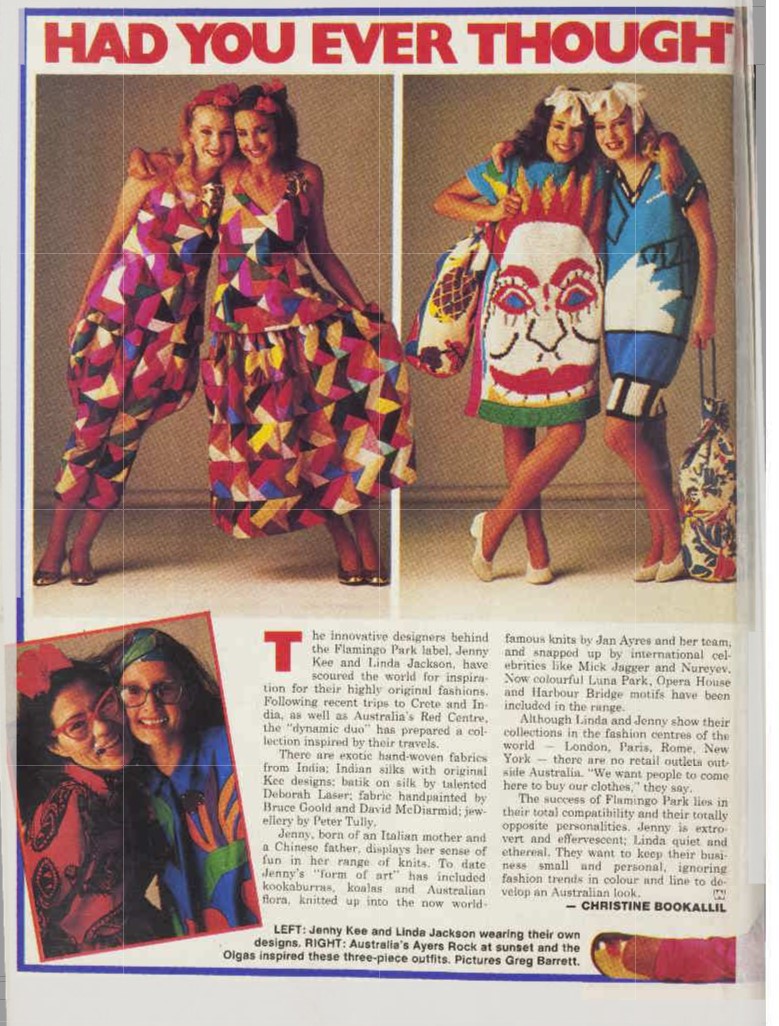
HAD YOU EVER THOUGHT OF WEARING LUNA PARK? (1980, November 5). The Australian Women's Weekly (1933 - 1982), p. 2. Retrieved from http://nla.gov.au/nla.news-article51772979
New styles for Aust. presents
When Coo-ee Australian Emporium opened last year it aroused great interest in its range of Australian crafted gifts. Moving right away from the cheap, Asian produced souvenirs most most frequently available, Coo-ee Australian Emporium sells finely crafted fabrics, glassware, ceramics and jewellery with an Australian flavor.
A number of top Australian craftspeople exhibit at the Emporium, many of them showing a vivid and refreshing approach to “cliched” Australian emblems like waratahs and wattle.
Towards the end of the year .the Emporium will feature Bathurst Island Tiwi Aboriginal pottery, fabrics and artefacts. It will also show a selection of modern Australian works including Robin Best’s plates and bowls, glassware from the award-winning Budgeree works, sculptured vases from Jenny Orchard and Angela Ireland, decorative plates from Greg Wain and silver jewellery by Attica Rae.
There is also Illaria Logi’s new Australian range of silver and gold bookmarks and napkin rings, fun jewellery by Peter Tully and Kate Durham, Bruce Goold’s expanded range of handprinted T-shirts, sweatshirts, fabrics, teatowels and linen sheets and Julia Sale’s appealing range of designs, including Waltzing Matilda, Sydney chop suey. New styles for Aust. presents (1982, August 26). The Australian Jewish Times (Sydney, NSW : 1953 - 1990), p. 18. Retrieved from http://nla.gov.au/nla.news-article263254707
How they dressed up Australia and put it on sale
RICHARD BAKER was a man gripped by a wholesome passion for the waratah, so much so that he was nicknamed Commander-in-Chief of the Waratah Forces. He led the battle against the Wattle League, a fervent band formed in Melbourne in 1911 to press for the choice of the wattle as Australia's national flower. Alas, the waratah lost. Some people said it was too stiff and spiky.
Baker, a botanist, was the curator of the Technological Museum in Sydney from 1888 to 1921 and acquired local artefacts for its collections. His enthusiasm for Australian flora was partly responsible for our golden age of design, a patriotic time which unfolded in the warmth of approaching Federation and was withered by World War I and the slickness of mass production. It was a time when kangaroos, waratahs, wattle, emus, flannel flowers, eucalyptus and other distinctive species were celebrated by Australian artists and craftsmen, and manufacturers chose their proud trademarks from the same crowd. ...
The Sydney shop Coo-ee, also known as the Australian Emporium, is an agency for Tiwi designs, an Aboriginal screen-printing co-operative from Bathurst Island which uses natural motifs beautifully, and also for the Sydney artist Bruce Goold.
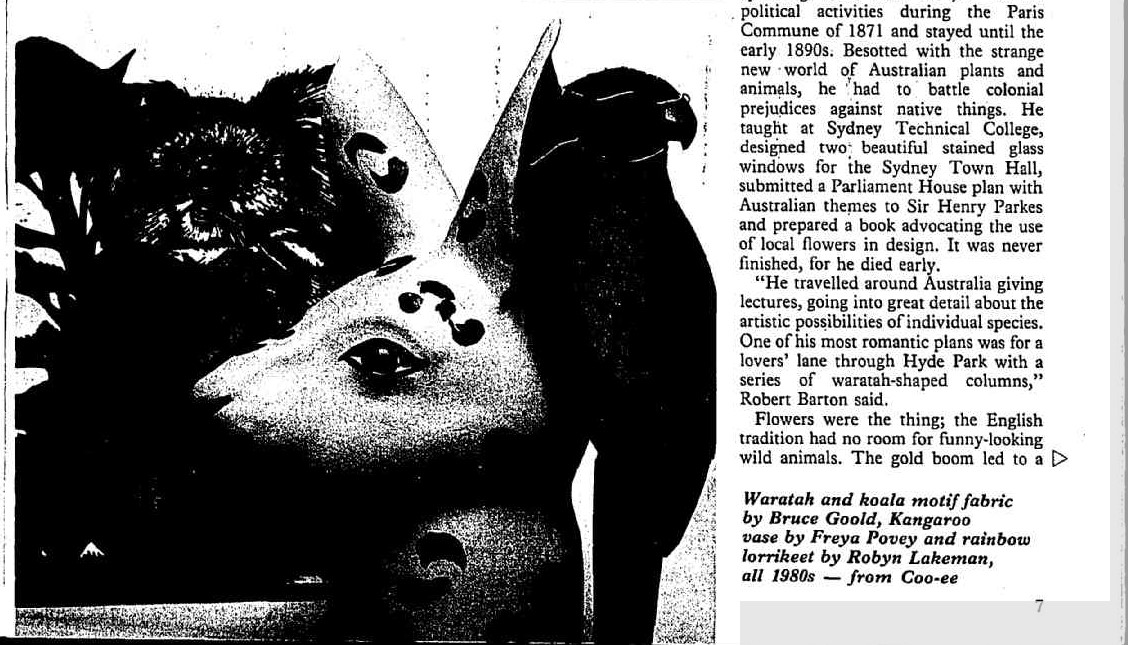
Waratah and koala motif fabric by Bruce Goold,
Goold's linocuts of waratahs, wattle and magpies would please Lucien Henry and Richard Baker. He produced a screenprint recently with a repeating pattern of waratah seed pods, though he was not thinking of the Mint museum's antique table elaborately carved with waratah pods and flowers.
Goold grew up at Newcastle where his grandfather kept a sort of folk museum, and developed an appreciation of appealing objects from the past, like horse-collars and butter-churns. His family used to holiday in the Blue Mountains where he became familiar with the sight of banksias and with the sharp black edges of the bush after a fire, like a charcoal drawing.
"It upsets me to see so many parodies about," Goold said. "People can't seem to draw a kangaroo, for instance, without some element of caricature.
"With the Bicentennial this nostalgia for old Australian things will go overboard. There'll be a glut of humorous koalas — though I like the koalas in Norman Lindsay's Magic Pudding; you can see his appreciation of the animals. You almost have to try to re-establish something sincere. Magpies and currawongs seem more honest to me than exotic birds of paradise."
PHOTOGRAPHY BY GERRIT FOKKEMA. 1985 How they dressed up Australia and put it on sale (1985, April 7). The Canberra Times (ACT : 1926 - 1995), p. 6 (GOOD WEEKEND). Retrieved from http://nla.gov.au/nla.news-article122471532
Coloured Stone, Wild Desert Rose (RCA Records).
THE COVER design, which is a linocut print by Bruce Goold, is impressive, but the album falls a little short of expectations. .....

While I can't complain about the vocals, musicianship or even the material, the production is not 100 per cent and leaves the album with a rather amateurish sound. By far the best song on the album, Doesn't Matter, is also, unfortunately, the shortest song on the album.
It is a punchy rock/pop number and surpasses the quality of many of the other songs on the album, which tend to be a little dreary...RECORD REVIEWS (1988, December 22). The Canberra Times (ACT : 1926 - 1995), p. 25. Retrieved from http://nla.gov.au/nla.news-article102039178
Bruce held solo exhibitions in Melbourne and internationally in London and Ireland from 1988 to 1989, taking the family to Dublin to stay with the Sheridans.
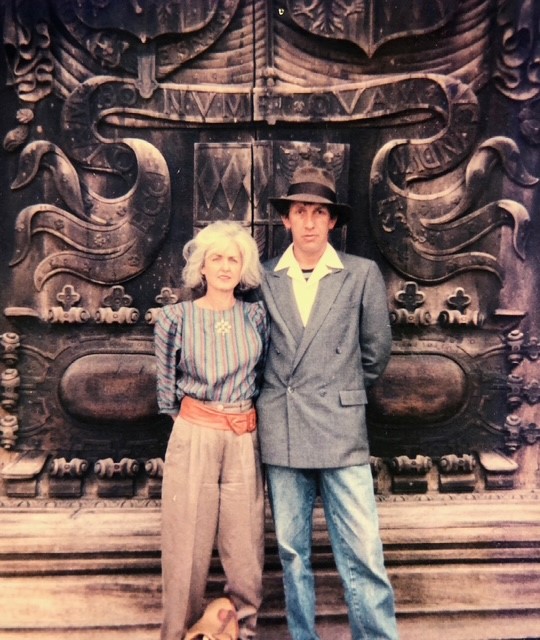
Bruce and Katie in the UK
The family returned to Palm Beach in 1990. Locally his works could be found in places like the Cafe for Obscure Avalon Painters, then sited in MacMillan court - in fact Lizzie and Paul refused to stock anyone except Bruce. I date my first Waratah t-shirt from then, and those beautiful fabrics for the best cushions.
After further exhibitions at Paul Craft's Gallery in Melbourne and Rex Irwin in Sydney, during the 1980's-90s Goold showed at the prestigious Josef Lebovic Gallery specialising in works on paper.
Josef described Bruce as:
"My stable of one, the only living printmaker I have represented. His approach whilst mirroring that of established printmakers such as Margaret Preston, is more direct, freer, more immediate, his hand-colouring fresh and vibrant."
Bruce received major commissions for poster, logo and interior design and worked as a designer for Mambo.
Dare Jennings, founder of the Mambo label, had seen one of Bruce's prints at Josef Lebovic's gallery, an image with a jazzy rose print in the background. Mambo were printing radical fabrics at the time. He asked Bruce to design a rose fabric and the art deco Woodcut Rose pattern was created. Dare then printed Sunflower yardage based on Bruce's linocut version of the ‘Van Gogh Sunflowers’ design and used for the title wall of the Art Gallery of New South Wales Yellow House exhibition.
Bogong Moths followed, completing the trilogy of fabrics launched on the smart Mambo stand at DesignEx in1990. Much in demand, Bogong Moths fabric was seen in the foyer of the Australia Council offices on their Anibou ’Longreach’ couches and was chosen by the Powerhouse Museum curators as a key fabric for their ’Inspiration’ display as one of the top twenty-five designs in their collection. A recent search shows shirts with this Mambo design on them are selling for $600.00.
A few insights from the press;
Master prints for Sydney fair
By SASHA GRISHIN
THE THIRD International Master Print Fair will be held from August 2-4 at the Hotel InterContinental in Sydney. The Fair attracts participants from overseas as well as Australia.
On view will be works by contemporary Russian and Japanese artists; posters designed by some of the world’s best-known artists, including Warhol and Rodchenko; works on paper by European, British and American artists including Picasso, Chagall, Miro, Bacon, Lautrec and Lichtenstein.
Works by contemporary, modern and traditional Australian artists include Arthur Boyd, Graham Fransella, Bruce Goold, William Robinson and Ken Done, as well as Aboriginal artists including Gloria Petyarra, Ada Bird and Turkey Tolson. Rare art books will also be featured.
The Fair was established in 1989 by Sydney print dealers Josef Lebovic and Akky van Ogtrop in recognition of the expanding Australian interest in works on paper.
A program of lectures and continuous demonstrations of printmaking techniques will run throughout the three days of the Fair. It will give the public an opportunity to learn about works on paper and to purchase examples. A children's view might lift standard ....Master prints for Sydney fair (1991, July 26). The Australian Jewish News (Sydney, NSW : 1990 - 2008), p. 38. Retrieved from http://nla.gov.au/nla.news-article261611866
Mary MacKillop: A tribute, Parliament House, Closes June 28, daily 9am-5pm.
ART MADE to order presents a difficult task for any artist. When the patron is a religious organisation operating in the 1990s, then it is a tall order indeed.
The Mary MacKillop Art Award is a once-only award established by the Sisters of St Joseph to commemorate the beatification of Australia's first Roman Catholic saint.
If the respected panel of judges arrived at this short list of 48 works, then the long list of more than 200 must have been woeful indeed. ost of the work in this exhibition is pedestrian, tired and stylistically anachronistic.
The winning entry, Shen Jiawei's Mary MacKillop of Australia, is in the undistinguished Soviet Socialist Realist style which in turn was derived from the work of 19th century Russian realist painters such as Repin, Perov and Mjasoedov.
The style was carried to China by Soviet artists who trained Chinese artists in the post-1949 period. Now Chinese artists like Shen Jiawei, who trained at the General Institute of Fine Arts in Beijing, are communicating this style to Australia.
The winning entry echoes the pictorial formula devised by Mjasoedov and popularised in countless later variations.
Of the paintings in an exacting realist manner, the finest in this exhibition is that by Brian Dunlop, where there is some indication of an other-worldliness.
Most of the others simply mix sentiment with bad academic painting.

Bruce Goold's Mary MacKillop, one of the works on show.
A children's view might lift standard (1995, June 17). The Canberra Times (ACT : 1926 - 1995), p. 7 (Saturday MAGAZINE). Retrieved from http://nla.gov.au/nla.news-article127531285
More to mambo than dancing
WHAT'S Mambo Streetwise youngsters know, surfers know, people who study streetscapes and graffiti know. And if you gallop into the Players area of the Canberra Playhouse, anyone interested in art can see this genre, cult, craze, movement (give it a name), then Mambo becomes something else besides the name of an obscure Latin American dance, popular in the '50s.
A human-sized blowfly on a surfboard greets the visitor in the foyer, and it is just a small tasfe of the work inside. It has been put together by ACT Health, Community Arts of Tuggeranong and the Canberra Theatre Trust; on show all this month, then it moves to Cairns.
The hidden message is a smoke-free future for the young, a demand for a machine-washable youth culture, without smoking.
Reg Mombassa is behind it all, his touch is seen in a" dozen exhibits that are cheeky, mould-breaking and tricksy. There are model cars made from cuttings from olive oil tins, brilliantly figured surf boards with roses and Madonnas and skulls; carpets with crook chooks regurgitating all over them. No, not for your floor. These are on-the-wall exhibits.
The other artists represented are Paul Worsten, Matthew Martin, Robert Moore, Bruce Goold and Jim Mitchell.
Opening day was Friday, with Federal ACT MP Brendan Smyth giving up his lunch hour to doing the opening honours, | urged on by Domenic Mico, I Tuggeranong's community Arts I director. Also enjoying the | show were Angela Phelp, David Williams, Roland Manderson, Bill Wood, Irene Hesterman, Kerry-Anne Cousin and Pam Evans. - NORMA ALLEN More to mambo than dancing (1995, June 19). The Canberra Times (ACT : 1926 - 1995), p. 15. Retrieved from http://nla.gov.au/nla.news-article127531576
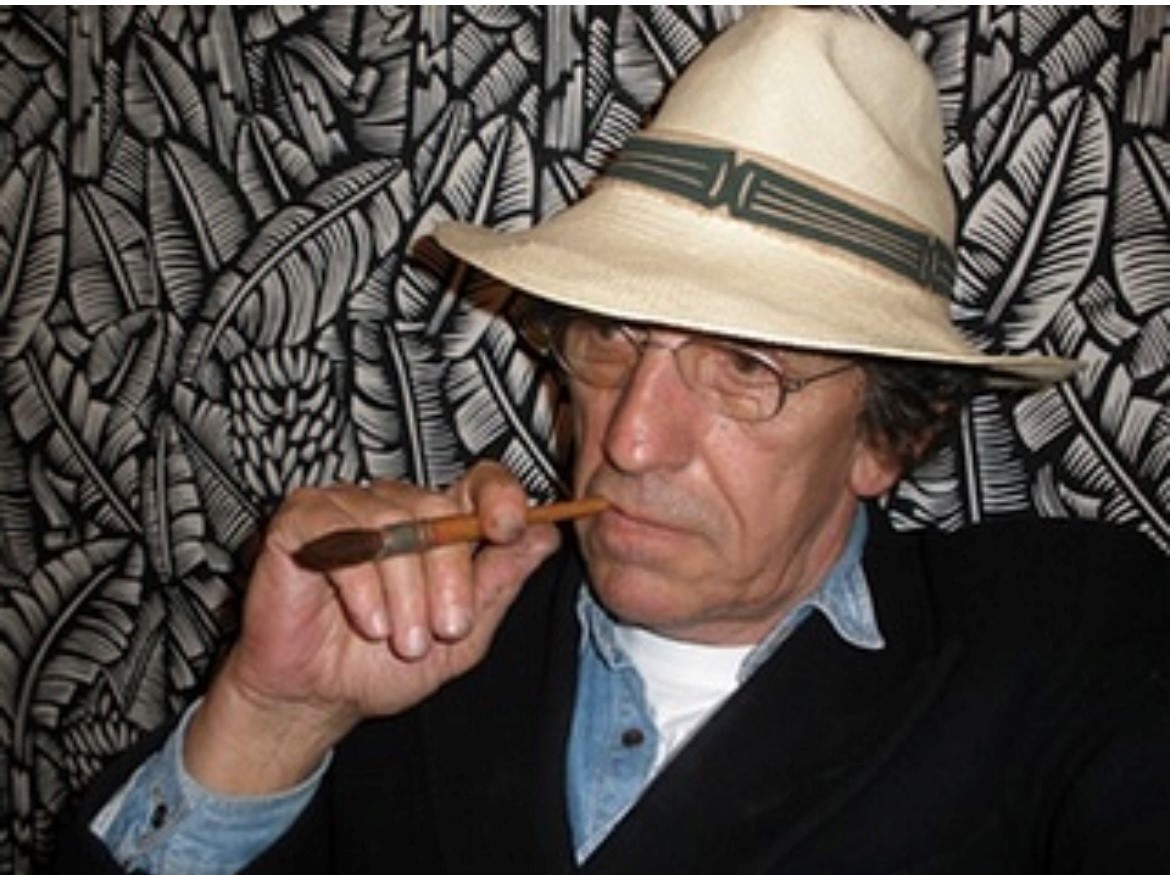
The Artist ! Banana Grove Fabric behind him (2011). Custom hat band by Bruce!
Bruce went on to design ‘Loud’ rayon shirts for Mambo, a take on the popular Hawaiian 50's style using Australian imagery. Bruce's designs were tropical and quirkily decorative. His last shirt was designed for the Olympic year 2000, and then the company changed hands.
His work is held by Artbank, Sydney; the Art Gallery of South Australia, Adelaide; the National Gallery of Australia, Canberra and several regional collections.
A retrospective exhibition, Bruce Goold, Artist, Designer, Printmaker, curated by Therese Kenyon, was held at Manly Art Gallery & Museum in 2008. A commercial gallery exhibition was inclusion in Artists Prints Made with Integrity, at Australian Galleries, Melbourne, 2010. In November 2010 Australia Post released his linocut designs for the official Christmas stamp set.
Katie Goold, known for her beauty and chicness, passed away in August 12 2018.
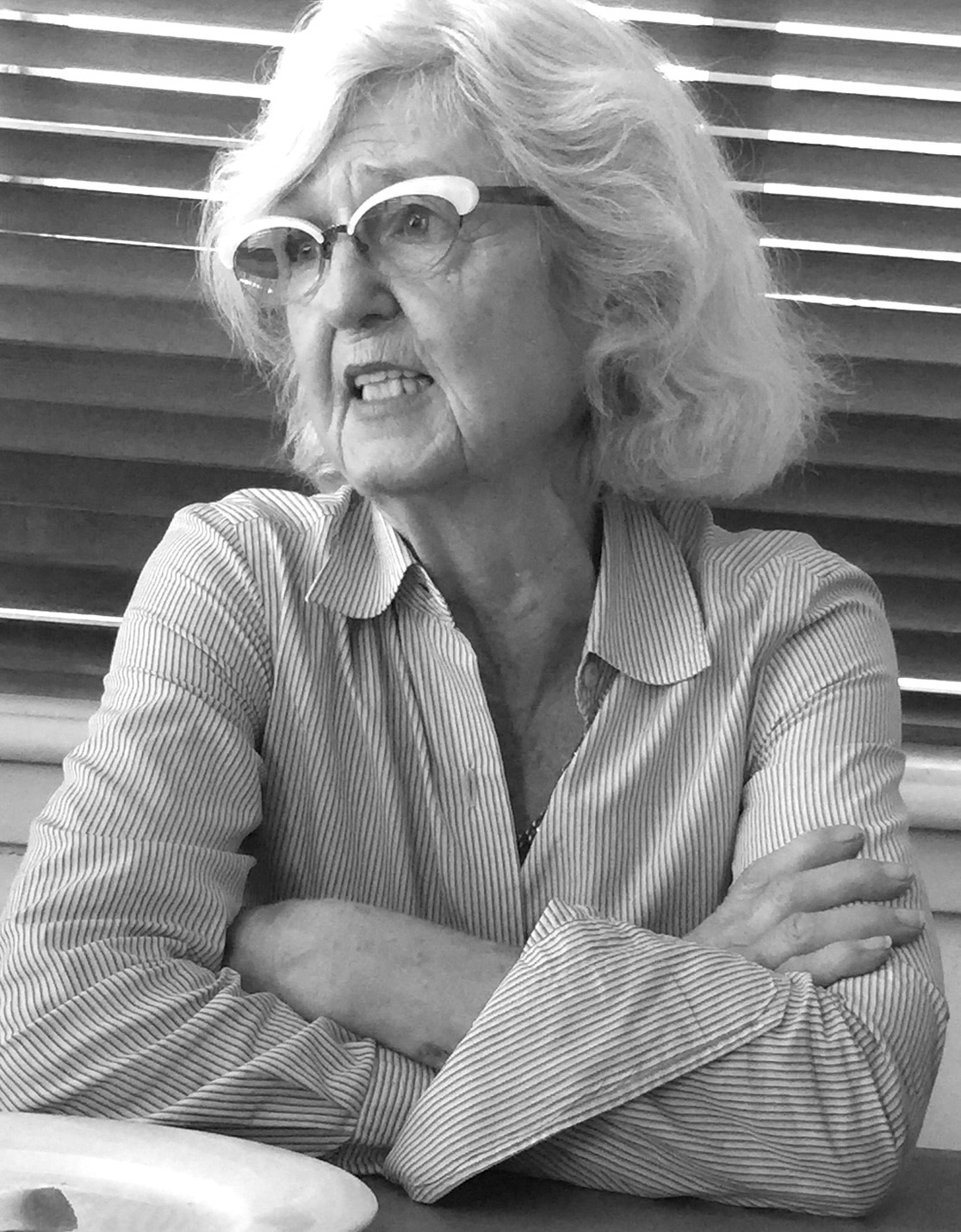
Katie
There was so much done over so many years, he was even working on a new waratah, our favourites, when he passed that a list compiled by Simon Cooper runs below.
There have been thousands of messages of condolence to Nancy since Monday June 16, among them this from one who knew him since the early days:
The artworld at large particularly in Sydney will be much saddened by the death of Master Printmaker Bruce Goold who left us on Monday the 16th of June. A man of great character, brilliant observer and artistic ability.
My first encounter with Bruce was during the period of the Yellow House at Macleay Street in Potts Point, it was obvious then if you engaged in conversation with Bruce, you needed to set aside half an hour at the very least, he was so interesting. He was wonderful at describing his observations and opinions of life and all the more remarkable in the way he developed those observations into artworks – Bruce was Artist to the core. He was a great contributor to the well-being of this Nation’s culture. To visit Bruce’s studio at Palm Beach was to experience cultural chaos – beautiful tools of the trade of a printmaker all at hand, objects and specimens collected over decades and an air of things that mattered, resulting in a significant body of printmaking, painting, collage, assemblages, and textile design, all taking us to a place we hadn’t been before.
His exhibitions were great events and drew crowds of great admiration.
I hate these artistic creatures leaving us, there’s been too many lately. The news weakens us immediately of their parting, but their profound lives leave us all stronger in the long run. — Stuart Purves, director of Australian Galleries
Just as Bruce was influenced by a variety of art styles, from comics to shadows cast on screens, he has in turn influenced an inspired the next generation. We see his work going forward in this, just as he developed his unique works. He was prolific, an amazing artist, and a kind, thoughtful, articulate and gentle man.
His daughter Nancy, a brilliant stylist and consultant, has responded to the thousands of tributes that have been sent - saying:
Thank you to each and every one of you for all your heartfelt messages about Bruce ❤️ Thought I would say thank you by sharing something I think is quite special. An artwork Bruce was working on. An unfinished lino cut that will (sadly)never be finished. As you can see it’s of a single Waratah, wrapped in its brown paper robe, it was destined to be cinched with a big red bow. Big expressive BG energy !
❤️Love, Nancy (and Bruce)

Nancy and Bruce in the garden at Palm Beach
BIBLIOGRAPHY
Compiled by Simon Cooper, Australian Galleries
SOLO EXHIBITIONS
2021 ‘Linocuts’ (online exhibition), Australian Galleries
2013 ‘Sydney Opera House 40th Anniversary linocuts, woodcuts & other works’, Australian Galleries, Roylston Street, Sydney
2008 ‘Bruce Goold: Artist, Designer, Printmaker’, Manly Art Gallery & Museum, Sydney
2006 ‘Woodcuts and Linocuts’, Australian Galleries Works on Paper, Sydney
1991 Josef Lebovic Gallery, Sydney
1989 England & Co, London, England
1988 National College of Art and Design, Dublin, Ireland
1987 Josef Lebovic Gallery, Sydney
1986 Josef Lebovic Gallery, Sydney
1982 Rex Irwin Art Dealer, Sydney
1981 Queen Street Galleries, Sydney
Paraphernalia, Melbourne
GROUP EXHIBITIONS
2019 ‘papermade’, Australian Galleries, Melbourne
2016 ‘Conjuring, Alchemy and Allure’, Australian Galleries, Melbourne
2015 ‘An exhibition of paintings, sculpture & works on paper’, Australian Galleries,
Roylston Street, Sydney
2014 “Mambo – 30 years of shelf-indulgence”, The Ian Potter Centre, National Gallery of Victoria, Melbourne
‘one of each’, Australian Galleries, Derby Street, Melbourne
2013 ‘Utzon’s Opera House’, S. H Ervin Gallery, Sydney
2012 ‘Australian Artists and the Sydney Opera House’, Utzon Centre, Aalborg, Denmark
2011 ‘large exhibition of small works’, Australian Galleries, Roylston Street, Sydney
‘large exhibition of small works’, Australian Galleries, Derby Street, Melbourne
2010 ‘Artists’ Prints made with Integrity I’, Australian Galleries, Smith Street, Melbourne
2008 ‘Stock Show’, Australian Galleries, Glenmore Road, Sydney
2006 ‘50th Anniversary Exhibition’, Australian Galleries Painting & Sculpture, Melbourne
2004 ‘Sailor Style’, Maritime Museum, Sydney
2003 ‘Wild Nature’, Art Gallery of South Australia, Adelaide
2001 ‘Mambo Flags’, Museum of Contemporary Art, Sydney
2000 ‘State of the Waratah’, S.H. Ervin Gallery, Sydney
1999 ‘Celebrating Paradise’, Manly Art Gallery & Museum, Sydney
‘Yellow House Now’, Michael Nagy Fine Art, Sydney
1998 ‘Escape Artists – Modernists in the tropics’, Cairns Regional Gallery, Cairns, QLD
‘Flagging the Republic’, Sherman Galleries, Sydney
1994 ‘Mambo Artists’, Ray Hughes Gallery, Sydney
‘P&O Art Awards’, S.S. Makambo, Australia
1995 ‘Mary Mackillop: a tribute’, Powerhouse Museum, Sydney
1990 ‘Yellow House Retrospective’, Art Gallery of New South Wales, Sydney
‘Yellow House Artists’, Joseph Lebovic Gallery, Sydney
1988 ‘Identity’, Bi Centennial travelling exhibition, Australia
1987 ‘The black and white tradition’, Penrith Art Gallery, Penrith, NSW
1984 ‘Art Clothing’, Art Gallery of New South Wales, Sydney
‘Printed fabrics’, Coo-ee Emporium, Sydney
COMMISSIONS
2005 Presentation set of prints, Nagoya, Japan
2004 Prints and logo, Wakaya Island, Fiji
2003 Four lino cut prints; Cockatoo, Magpie, Kookaburra and Lyrebird for the
City of Sydney, Lord Mayor’s Corridor, Sydney
Illustrated map of the world in mural form for Volkswagen – Head Office, Botany, Sydney
2002 Whaling harpoon display, cabinets and café design, Lord Howe Island Museum, Lord Howe Island
Ten years designing for Mambo, Sydney
2001 Fabrics for Balinese resorts and bar in Mystique, Wijaya, Bali
2000 Olympic Arts Festival Poster, Waratah Flame, Sydney
1999 IBM Pavilion, five tropical designs for the Interior Internet Café – Surfshack,
Darling Harbour and Olympic Village, Sydney
1997 Wildlife series, Northern Beaches Journal, Sydney
Poster, Sydney Theatre Company, Sydney
1995 Palisade Hotel Restaurant & Logo Design, Sydney
1993 Design for Makambo Bar, Lord Howe Island
1992 Inlaid Lino Mural “Flying Boat and Shipping’, Lord Howe Island
1991 Mural and décor for Beach Road Restaurant, Palm Beach, Sydney
1990 Design of banners and sunflower fabric for entrance to Yellow House Retrospective, Art Gallery of New South Wales, Sydney
1988 Circular terrazzo floor design of Currawongs, berries and Waratah tiles for Darling Harbour, Sydney
Powerhouse Poster, Powerhouse Museum, Sydney
Bilson’s, Quay Restaurant Poster & Logo, Sydney
1987 Works for the Australian Bi-Centennial Authority, Sydney
Bi-Centennial Festival of Sydney – Official Poster, Sydney
1984 Poster for the Australian Museum, Sydney
COLLECTIONS
- Artbank, Sydney
- Art Gallery of South Australia, Adelaide
- Australian Museum, Sydney
- Australian National Maritime Museum, Sydney
- Lord Howe Island Museum, Lord Howe Island
- Manly Art Gallery & Museum, Sydney
- National Gallery of Australia, Canberra
- Powerhouse Museum, Sydney
- Sydney Town Hall Collection, Sydney
- Victorian Museum of Performing Arts, Melbourne
BOOKS
- Art Irritates Life, Mambo
- Celebrating Paradise, exhibition catalogue, Manly Art Gallery, Sydney
- Mary MacKillop, exhibition catalogue, Maritime Museum, Sydney
- Nice, Rosie; State of the Waratah, exhibition catalogue, S.H. Ervin Gallery, Sydney
- Osborne, Margaret; Wild Nature, exhibition catalogue
- Sailor Style, exhibition catalogue, Maritime Museum, Sydney
- Still life with Franchise, Mambo
- Wilson, Gavin; Escape Artists, exhibition catalogue
- Yellow House, catalogue, The Art Gallery of New South Wales, Sydney
ILLUSTRATIONS FOR BOOKS, ARTICLES AND RECORD COVERS
- Dryson, Nick; “Wildlife”, Good Weekend Magazine, Illustrations
- Dryson, Nick; “Wildlife”, Illustrations, Collins, Sydney
- “Fellini Cavazzoni– Voice of the Moon”, Cover Illustration
- “John Dale Dark Angel’, Serpents Tail Press
- Niland, Darcy; “Short Stories”, Illustrations
- Patric Juillet Cookbook” Illustrations
- Patterson, Banjo J.M; “Poems of the Bush”, Illustrations. Dent.
- Sunday Times Magazines, Illustrations
- “The Hanged Man in the Garden”, Cover Illustration, Halligan & Penguin, Sydney
- “The Jumping Jeweller of Lavender Bay”, Illustration Cover, Penguin Books, Sydney
- Tennant, Kylie; “The Battlers”, Illustrated covers, Angus and Robertson, Sydney
- Tennant, Kylie; “Tiburon”, Illustrated covers, Angus and Robertson, Sydney
- Tennant, Kylie; “Foveaux”, Illustrated covers, Angus and Robertson, Sydney
- “Wild Desert Rose’, Coloured Stone, RCA record cover
- Bogon Moth Textile, in the Powerhouse Museum, selected as one of the top twenty-five modern
- Australian designs in their collection, Original Powerhouse Poster to be used as frontispiece for the catalogue, 125th Anniversary Exhibition. August 2005.


